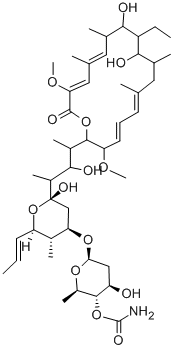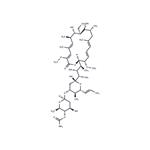Description
Concanamycin A (80890-47-7) is a potent and specific inhibitor of the vacuolar (V-type) H+-ATPase which can induce apoptotic cell death in various cell lines.1,2?Inhibits cell surface expression of virus envelope glycoproteins.3?Dramatically increases the rate of extracellular vesicle release from a variety of cell types.4?Inhibits autophagy by blocking lysosomal acidification.5
Uses
Concanamycin A has been used:
- as a lysosomal inhibitor in young and old fibroblasts
- as a vacuolar-type H+-ATPase inhibitor in presynaptic vesicles
- as a lysosomal acidification blocker in HepG2 hepatocytes cells
Uses
Concanamycin A is the major analogue of the concanamycin complex produced by Streptomyces sp.. It has been shown to act as a potent and specific vacuolar-ATPase inhibitor. Concanamycin A inhibits the acidification of organelles and blocks cell surface expression of viral envelope glycoproteins without affecting their synthesis. It also interferes with intracellular protein trafficking and inhibits perforin- and Fas-based lytic pathways in cell-mediated cytotoxicity. Concanamycins are structurally related to the bafilomycins.
Definition
ChEBI: A concanamycin in which the lactone ring contains 4 double bonds and is substituted by 4 methyl groups, 2 hydroxy groups, 2 methoxy groups and an ethyl group.
General Description
Chemical structure: macrolide
Biological Activity
Specific inhibitor of V-type (vacuolar) H + -ATPase that displays > 2000-fold selectivity over other H + -ATPases (IC 50 values are 9.2, > 20000, > 20000 and > 20000 nM for yeast V-type, F-type, P-type H + -ATPases and porcine P-type Na + ,K + -ATPase respectively). Blocks cell surface expression of virus envelope glycoproteins without affecting synthesis and exhibits cytotoxicity in several cell lines.
Biochem/physiol Actions
Concanamycin A (ConA) inhibits acidification of organelles and perforin-mediated cytotoxicity. It is a vacuolar-type v-ATPase inhibitor. ConA possesses antiprotozoal and antineoplastic properties. It mediates inhibition of the negative factor (Nef) protein of the human immunodeficiency virus.
References
1) Nishihara?et al.?(1995),?Specific inhibitors if vacuolar type H(+)-ATPases induce apoptotic cell death; Biochem. Biophys, Res. Commun.,?212?255
2) Hong?et al. (2006),?Nitric oxide production by the vacuolar-type (H+)-ATPase inhibitors bafilomycin A1 and concanamycin A and its possible role in apoptosis in RAW 264.7 cells; J. Pharmacol. Exp. Ther.,?319?672
3) Muroi?et al.?(1993),?Folimycin (concanamycin A), a specific inhibitor of V-ATPase, blocks intracellular translocation of the glycoprotein of vesicular stomatitis virus before arrival to the Golgi apparatus; Cell Struct. Function,?18?139
4) Cashikar and Hanson (1987),?A cell-based assay for CD63-containing extracellular vesicles; PLoS One,?14?e0220007
5) Gradzka?et al.?(2018),?Inhibitor of apoptosis proteins are required for effective fusion of autophagosomes with lysosomes; Cell Death Dis.,?9?529


